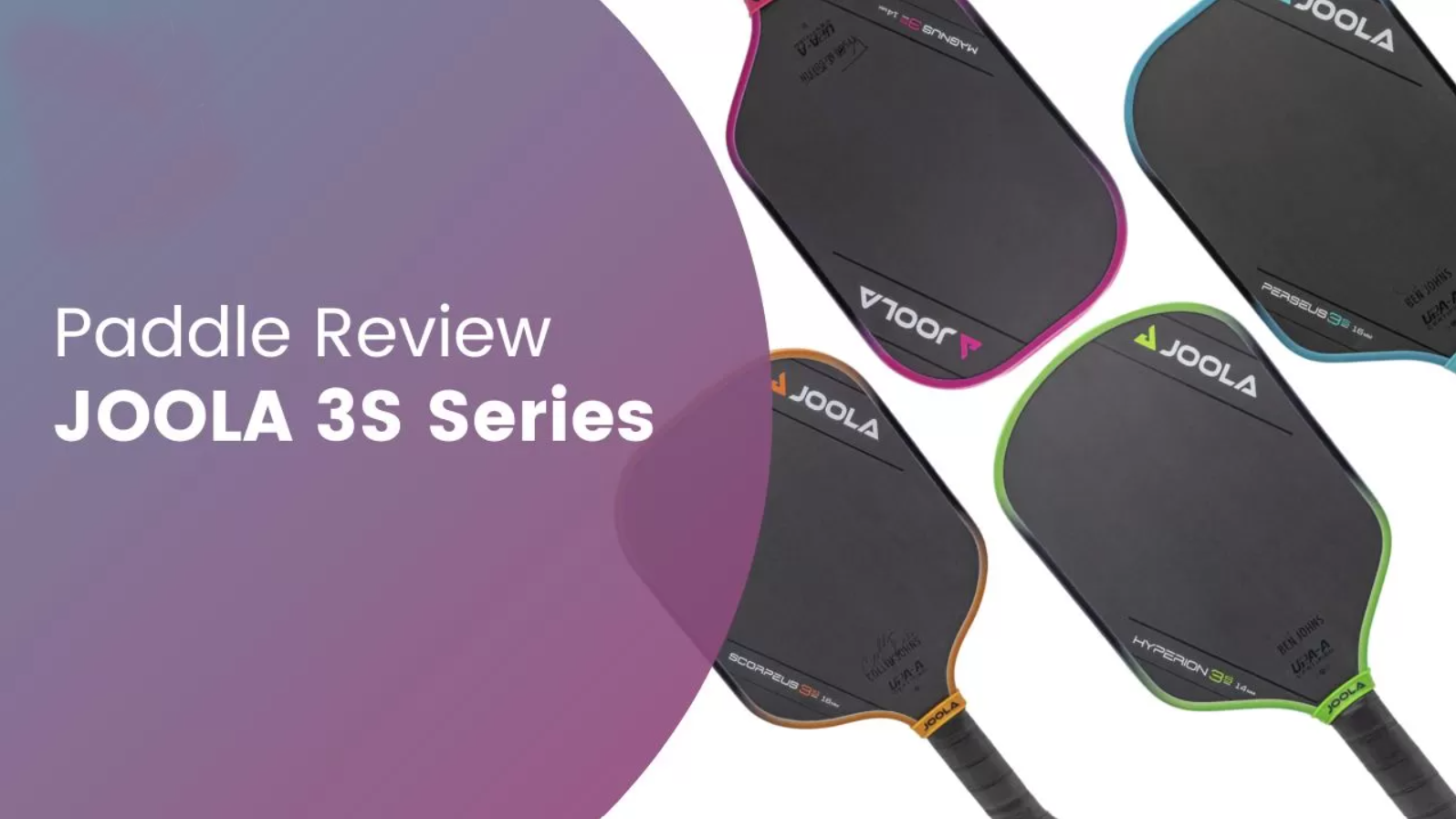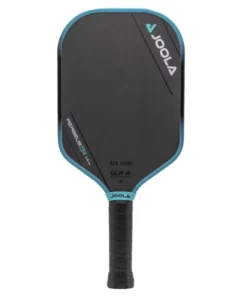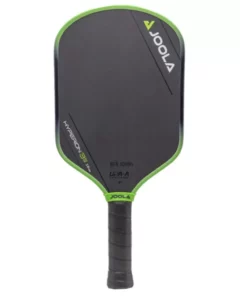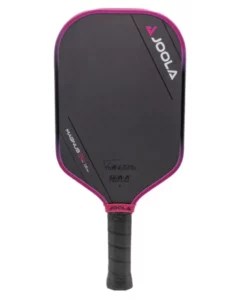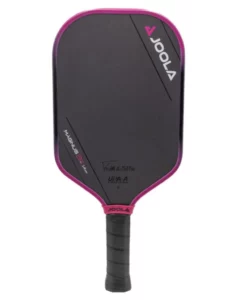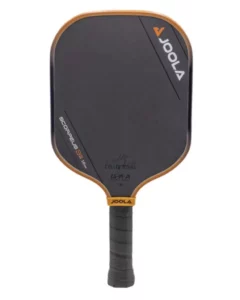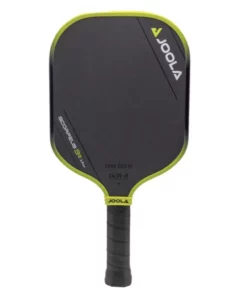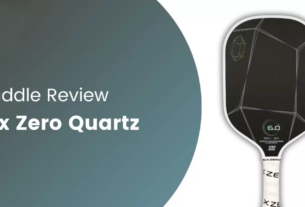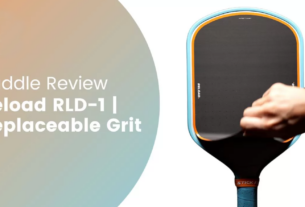In 2024, JOOLA experienced a transformative year in the pickleball world, marked by major developments that reshaped both their product line and their position in the industry. It all began with the introduction of their Gen 3 JOOLA paddles in April, which quickly garnered attention. However, by June, these paddles were removed from the USAP-approved paddle list, leaving many players and fans surprised. In response, JOOLA swiftly released their Mod-TA 15 paddles in August, a new version featuring the Perseus shape, which closely resembled the original Gen 3 models but gained USAP approval. By September, JOOLA launched the much-anticipated 3S series, the focus of this review.
The original Gen 3 paddles stirred a mix of reactions, with some praising their power and others finding them too strong for their playstyle. When the Gen 3 paddles were discontinued, some players were disappointed, while others appreciated the forced transition to paddles with a more balanced power output. Now, JOOLA is back with the 3S series, but these paddles are UPA-A approved, rather than USAP approved. The critical question is: how do these paddles differ from the original Gen 3 models?
In this review, I’ll explore the construction of the 3S series, what the new UPA-A approval means, and how these paddles compare to the earlier Gen 3 models in terms of performance and playability.
JOOLA 3S Paddle Technology: What Sets It Apart from Gen 3?
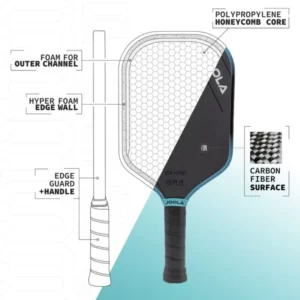
The diagram illustrates the composition of the JOOLA 3S models, showcasing the innovation behind these paddles. At the core of the design is the introduction of an additional layer of foam called the Foam Outer Channel. This foam, when combined with other structural elements, forms what JOOLA refers to as the Propulsion Core. Like their previous models, the 3S paddles are thermoformed and feature a raw carbon fiber face, a technology also used in their Gen 2 paddles.
If you’re familiar with the technology in the Gen 3 paddles that were removed from USAP’s paddle approval list, you’ll likely notice striking similarities in the design and structure of the new 3S paddles. In fact, side-by-side x-ray scans of the 3S and Gen 3 paddles show minimal differences, aside from minor foam expansion variations along the edges, which is to be expected. This initially caused some confusion for me as well, as the paddles appear almost identical.
However, after speaking with JOOLA, I learned there are distinct differences between the technologies, which I detail below the x-ray images.
These x-ray scans were generously provided by John Williams, a fellow paddle reviewer who does excellent work. You can visit his website for more in-depth paddle reviews at johnkewpickleball.com.
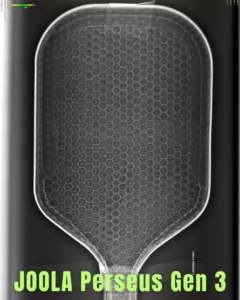
3S Technology vs. Gen 3 Technology: Key Differences Explained
Based on my analysis, there are two key distinctions between the JOOLA Gen 3 and 3S series paddles:
- Foam Treatment: Both series incorporate the same amount of foam, but the treatment differs. In the 3S models, the foam is designed to minimize expansion and pressure against the polymer core, whereas in the Gen 3 models, the foam was pressed more tightly against the core.
- Core Design: The handling of the cores is different. The Gen 3 paddles featured a “compressed core,” while the 3S series utilizes a “non-compressed core.” During the thermoforming process, components are arranged in a mold and heated to fuse them together. For the Gen 3 paddles, the cores were slightly thicker than the mold to create a compressed effect, trapping more energy for increased power. In contrast, the 3S models have cores that match the mold size, preventing compression.
Although these differences are subtle, they impact paddle performance. My power and pop tests indicated slightly lower numbers for the 3S models compared to the Gen 3s. However, the non-compressed core of the 3S paddles enhances durability, reducing the risk of core crushing or delamination—both positive changes in my view.
I highlight this in my performance overview, but it’s worth mentioning here as well: while the power in the 3S models is somewhat reduced, it remains impressive, placing them at the top of my paddle database for power. The pop numbers decreased more than the power, meaning that while the 3S paddles still deliver good pop, it isn’t as pronounced as in the Gen 3 models. This lower pop, however, contributes to greater control during play, making the paddles more manageable.
What is UPA-A Certification? An Overview
UPA-A is a new player in the paddle certification landscape, emerging as a competitor to the long-established USAP, which has governed paddle regulations and certification in pickleball since the sport’s inception. In response to criticisms of USAP’s testing and approval practices, the ownership of the PPA Tour launched UPA-A as their own certification entity. While UPA-A is still fine-tuning its operational procedures and has faced scrutiny, it has already partnered with JOOLA to certify their latest 3S paddles.
The JOOLA 3S models are uniquely UPA-A approved, meaning they do not hold USAP approval. This limits their use to competitions that permit UPA-A approved paddles, such as events on the PPA tour. For players participating in other events, acceptance can vary; some may allow UPA-A paddles, while others might restrict play to USAP approved models. However, for recreational players, this distinction is less critical since the paddles are certified by a recognized authority and are suitable for casual play.
So, how does UPA-A differ from USAP? While UPA-A is still refining its testing protocols, its interim certification guidelines tend to focus on reducing power compared to USAP rules. Meanwhile, USAP is also working to adjust its regulations to address the influx of high-power paddles. As for which organization is superior, both have their advantages and disadvantages, and each is committed to capping power and enhancing their testing methodologies. The future of paddle certification remains uncertain, but for now, we have two bodies navigating this evolving landscape.
Regarding the acceptance of UPA-A paddles, they are approved for all PPA events, but unlikely to be accepted at APP events. Local clubs and tournaments may have varying policies; some clubs allow UPA-A paddles, while others are waiting to see how the situation develops. Given that UPA-A rules currently reduce paddle power compared to USAP, it’s reasonable to expect that more clubs will eventually accept UPA-A paddles as time goes on.
3S Paddle Series: Identity and Performance Summary
General Performance
Every paddle in the JOOLA 3S series is designed for power, although there are variations in power levels based on the different shapes and thicknesses available. Despite being toned-down versions of the original Gen 3 paddles, the 3S models still deliver impressive power and pop. My tests revealed that all paddles in this series rank in the 90th percentile or higher for power and above the 80th percentile for pop. Notably, the drop in pop for the 3S paddles was more pronounced than the decrease in power compared to the Gen 3 models.
One standout feature of the JOOLA 3S series is the variety of shape and thickness options available. Specifically, the 16mm options offer more forgiveness than many thinner core power paddles on the market. While most high-power paddles rely on thinner cores to achieve their performance, JOOLA successfully balances both thick and thin designs. This ability to offer multiple configurations is an advantage that larger brands like JOOLA have over smaller companies, thanks to their greater capital and resources.
Power and Pop
When I refer to power, I mean the ball speed generated during full swings, such as drives and serves. The power available in the 3S paddles is distinct from other high-power paddles because there isn’t a significant power cap. The technology used in these paddles rewards players with increased power the harder they swing. For strong hitters, this translates to significant power gains. Conversely, if you’re not generating a lot of your own power, you’ll still benefit from a boost, though it may not be as dramatic as expected.
You might wonder how these paddles differ from others. The key is in the exponential power growth they offer. In practical terms, swinging twice as hard doesn’t simply double your power; it can result in three times the power. This unique characteristic becomes evident once you play with them. Additionally, as the paddles break in over time, they become even more powerful, though the level of break-in isn’t as pronounced as it was with the Gen 3 models. While the Gen 3 paddles gained substantial power after extensive use, the 3S paddles experience a more modest increase during their break-in period.
In terms of pop, which refers to the ball speed generated from shorter swings like punch volleys, the 3S models perform admirably but not quite at the level of the Gen 3 paddles. They maintain a strong profile for both power and pop, but the pop isn’t as overwhelming as it was in the Gen 3 lineup.
Practical Implications of Power
The added power from the 3S paddles opens up various tactical opportunities. Players can score more easily from drives, apply pressure on serves and returns, and conclude points quickly when the ball is left high. Additionally, this power enhances defensive capabilities against baseline drives, making it easier to block shots with pace and depth—a significant improvement for my own gameplay.
However, access to this extra power may not suit every player, which I’ll address in the control section.
Important Note on Break-In Period
It’s worth noting that these paddles require a break-in period, during which the power level may increase slightly after a week of use. The power levels I reported were based on several hours of drilling and play with each paddle, so keep this in mind if you decide to purchase one.
Feel and Control
The JOOLA 3S paddles offer a more manageable feel compared to the original Gen 3 models. While the pop is toned down, this adjustment leads to improved control. With the Gen 3 paddles, it was common to overshoot balls or hit wide on tough angles, but the 3S series mitigates this issue. The power in these paddles feels somewhat hidden; players must put in the effort to unlock it. This creates a dynamic experience: when the ball moves slowly or your swing is less aggressive, control is enhanced. However, with faster balls or stronger swings, the pop and power become more pronounced, making it challenging to soften shots from midcourt or the kitchen.
The impact feel of the 3S paddles is unique, described as lively and hard, rather than stiff or plush. The 14mm versions accentuate this feel more than the 16mm variants. Personally, I preferred the feel of the 16mm models as they became more familiar with play, while still providing a firmer, more responsive touch compared to other carbon fiber paddles.
While the control is improved, these paddles still belong to the power category, requiring skill to manage effectively. Players must maintain awareness during counters and be gentle with low balls to avoid hitting long. Nonetheless, the 3S paddles are generally more accessible than their Gen 3 predecessors.
Sweet Spot and Forgiveness
The sweet spot on the 3S paddles aligns well with expectations for each shape. They are more forgiving than the Gearbox Power Pro paddles, offering more life at the paddle tip. However, the vertical sweet spot differs from typical thermoformed paddles.
In standard thermoformed paddles, there’s a consistent response across the entire face, including the throat area. While the bounce near the throat may be less responsive, it remains adequate for play. In contrast, the Gen 3 models experience a more pronounced drop-off in power as you move towards the throat. This means hitting with a tighter stroke can yield disappointing results if expecting sweet spot power, especially during defensive plays.
16mm vs. 14mm Options
The differences in ball trajectory between the 16mm and 14mm paddles become more pronounced with added power. The 16mm paddles produce a higher trajectory, leading to more arc in drives and drops compared to the 14mm versions. While this isn’t inherently positive or negative, it’s worth considering. Personally, I prefer the lower trajectory of the 14mm paddles, which complements my style by keeping shots down and in play. However, this lower trajectory can complicate deep returns and low-ball attacks.
The feel also differs between the two thicknesses; the 14mm paddles feel much harder. Testing revealed a general preference for the 16mm paddles. Moreover, the 16mm models tend to exhibit greater power from the baseline, while pop levels remain fairly comparable.
The sweet spot size also varies, with the 16mm paddles offering forgiving play, though not exceptionally so, while the 14mm paddles present tighter sweet spots. Specifically, the Magnus 3 and Perseus 3 in 14mm are more challenging, while the Scorpeus 3 retains a forgiving nature due to its shorter and wider design.
Spin
In my spin tests, the paddles performed well, with several models averaging over 2000 RPM, which is impressive. Those that didn’t quite hit that mark were still close.
Maneuverability
The weight and swing weights of the paddles align with expectations for their respective shapes and thicknesses. Elongated paddles display higher swing weights and lower twist weights, while standard shapes exhibit the opposite.
The Big Question – Do You Need This Much Power?
Ultimately, the question is whether the extra power is worth the potential for increased errors. While the added power can create more scoring opportunities and pressure on serves, it can also complicate low ball attacks and lead to pop-ups when dinking. Players already proficient in generating power may benefit more from these paddles, as they enhance offensive strengths. Conversely, less offensive players might find control and consistency compromised.
Generally, I recommend choosing as much power as you can handle in a paddle. If you can manage the power in the 3S series, the benefits are likely to outweigh the drawbacks. Plus, these paddles are fun to play with, making them appealing for those seeking the latest in paddle technology.
Other Thoughts
It’s worth noting that these paddles are noticeably louder than many others, particularly the 14mm versions. Additionally, JOOLA is introducing an innovative NFC-enabled chip in the handle for paddle registration and authentication. This feature simplifies warranty claims and helps combat counterfeit products.
Performance Reviews by Paddle
In this section, I’ll provide a detailed look at the JOOLA 3S series, highlighting the nuances and performance metrics of each paddle I’ve tested.
Available Options
The JOOLA 3S series features four different shapes, each available in both 16mm and 14mm widths. The options include:
- Perseus: Ben Johns’ preferred shape, known for its longer handle length.
- Magnus: Tyson McGuffin’s choice, which has a shorter handle.
- Hyperion: Simone Jardim’s favored shape, featuring a longer handle and a curved top.
- Scorpeus: A standard shape that is shorter and wider, paired with a longer handle, preferred by Collin Johns and Anna Bright.
I’ve play-tested all models in this series and am ready to share my insights.
JOOLA Ben Johns Perseus 3S 16mm Review
The Perseus 3S 16mm paddle is designed for players seeking a balance of power and control. Here’s a breakdown of its performance:
- Power: The Perseus 3S offers impressive power, ranking in the 90th percentile among power paddles. The technology rewards aggressive swings, allowing for explosive drives and serves.
- Pop: While the pop is not as pronounced as in the Gen 3 models, it still performs well, landing in the 80th percentile. This makes it effective for quick volleys and punch shots without sacrificing too much control.
- Control: One of the standout features of the Perseus 3S is its improved control. Players will notice fewer misfires, especially on angled shots. The hidden power aspect requires effort to unlock, providing a dynamic experience that caters to varying swing styles.
- Feel: The paddle exhibits a lively, harder feel at impact, which might take some adjustment for players used to softer paddles. The 16mm thickness offers a more forgiving play compared to the 14mm options, making it easier to handle during longer rallies.
- Sweet Spot: The sweet spot is well-defined, providing solid performance across the paddle face, though there is a notable drop-off in power towards the throat. Players should be mindful of their swing angle to maximize the paddle’s potential.
- Maneuverability: The weight and swing weight align with expectations for elongated paddles, making it easy to maneuver during fast-paced exchanges. The longer handle allows for greater reach and flexibility in shot selection.
Overall, the Ben Johns Perseus 3S 16mm is an excellent choice for players who want to combine power and control, making it suitable for both aggressive play styles and those looking to improve their all-around game.
- Shape: 16.5″ x 7.5″ (elongated)
- Static Weight: 8 oz avg
- Swingweight: 119-123 (high)
- Twistweight: 6.2 (moderate)
- Face: Raw Carbon Fiber
- Grip Circumference: 4.25″
- Handle Length: 5.5″
- Core: 16mm Polypropylene Honeycomb
- Price: $280 (no discounts available for now)
- Warranty: Six months
JOOLA Ben Johns Perseus 3S 16mm Review (Continued)
The Ben Johns Perseus 3S 16mm paddle stands out as the choice of the number one male player in the world, Ben Johns. This paddle tested highest for power among its peers, making it a formidable option for serious players. Here’s a closer look at its performance characteristics:
- Power: With unparalleled power, this paddle excels in delivering speed and pressure on drives, serves, returns, and overheads. It’s designed to create significant challenges for opponents, forcing them into difficult situations. However, this increased power comes with a caveat: it’s easier to hit balls long if you’re not fully focused on each shot. Casual swings can lead to unforced errors, so maintaining concentration is crucial.
- Swingweight: The swingweight is on the higher end, measuring around 121. Paddles that exceed 120 tend to feel head-heavy, and this one is no exception. It’s important to note that the swingweight may vary slightly depending on the specific paddle weight you receive, likely falling within the 119-123 range. If you prefer an elongated shape but desire a lighter swingweight, the Magnus 3 16mm may be a better fit, as it offers a shorter handle and improved maneuverability.
- Twistweight: With a twistweight of 6.2, this paddle provides a balance typical for elongated shapes. It shows an improvement over previous models, making it more forgiving than the Gen 2 Perseus, which was known for its lack of forgiveness. However, the added weight may be a trade-off, so players should consider their playing style.
Who Should Consider the Perseus 3S 16mm?
This paddle is ideally suited for players with an aggressive, attacking style. Its high power rating and slightly heavier design make it a top choice for higher-level skilled players. If you have a well-developed game, this paddle can enhance your performance. However, less experienced players might find the power and weight lead to more errors than winners.
For those who appreciate the power of the Perseus 3S but seek something more conservative, the Scorpeus models could be a more suitable option.

